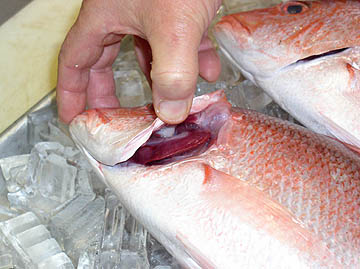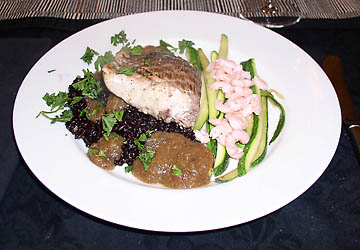
Flavor Notes by Robert Rich: Food, Wine, Restaurants & Recipes
Local Food Topics
Finding Fresh Fish
...and preparing it at Home
by Robert Rich, November 2003, for MV Voice
Chef's Shopping Lessons
I asked James Pei, chef-owner of Cafe Yulong, to share some tips on shopping for fresh crab and fish. This second installment highlights fresh fish.
We visited three different Asian markets together, where Pei contrasted the features of the fresh catch against older specimens. All of the markets had extensive seafood counters with live tanks full of crustaceans and freshwater fish, and rows of whole fish on ice.
The Mountain View Market (340 Castro St., Mtn. View) had some of the freshest catch on that particular day, but the live tanks needed cleaning. When I returned a few days later, the tanks were cleaner.
The New Wing Yuan Market (1139 Lawrence Expressway, Sunnyvale), whose owners used to run the New Castro Market, had a bright scrubbed environment. The fish were well iced, at medium freshness.
Ranch 99 Market (Milpitas Square Center, Barber Road, Milpitas) had the largest selection of all, with clean live tanks. On many days, Pei says it's the best place to go for fresh caught fish on ice, but we visited on a day between shipments so the quality varied.
Pei says the best markets are the busiest, so they cycle through their inventory quickly. However, even the best markets sometimes get poor shipments. Sometimes you'll see a few beautiful fish caught yesterday, lined up next to several from last week. Stay flexible, and buy what looks freshest.
Signs of Freshness
Pei showed me how to identify the signs of freshness. First, look for bright shiny colors in the fish scales. As a fish sits, its skin becomes more pale and dull looking, sometimes almost translucent.
The eyes of freshly caught fish look black and beady. Milky or sunken eyes are sure signs that a fish has been dead too long.
When you lift up the gill flap, you should see bright firm coral-red gills. Older gills become marked with red-black clots.
When you gently poke the flesh, it should feel firm and resilient, almost rubbery. As the flesh ages, it rebounds less to finger pressure and the indentation remains.
Iced or Live?
I asked Chef Pei about the different ways that fish come to market: living, iced, or deep-frozen.
He explained that usually only the freshwater fish and shellfish get sold from live tanks, in part because saltwater tanks cost a lot to maintain. However, live fish from tanks are not necessarily better than frozen. Dirty tanks can impart bad flavors. Crowded conditions can stress the fish, also affecting flavor.
Most ocean fishing boats clean their fish immediately after catching, then place them on ice or in deep freeze depending on when they expect to go to market.
Fish that have been frozen immediately after catching can maintain fresh flavors for months if vacuum sealed. Fish on ice (not frozen) will stay fresh for several days and generally have the best texture.
Once thawed, fish should not be re-frozen. If you buy fish on ice or alive, you should eat it the same day. You can ask your fishmonger to kill and clean live fish for you before you take it home.
Market Fresh on Sunday
Farmers' markets provide the rare opportunity to ask advice from the person who caught the fish.
At Mountain View's Sunday Market, Patrick O'Shea at Mission Fresh Fish sells cleaned fillets that his boats caught the previous day. Like most reputable fishmongers, you can ask him to suggest the best choices.
His fish costs more than some, but its quality excells. Independent fishermen like O'Shea also tend to practice more sustainable fishing techniques, since their own livelihood depends on the health of wild ocean populations.
He describes his fish as "sashimi grade" which means that it's fresh enough to eat raw.
If you prepare sashimi, you should only use saltwater fish. Freshwater species sometimes carry parasites that can infect humans. Cooking renders these parasites harmless. Even raw salmon can sometimes cause illness, since it spends time in fresh water.
With fish as good as O'Shea's, I prefer to cook it minimally, perhaps lightly dusted with herbs and spices then quickly seared. With a very hot skillet, the outside of the fillet gets lightly charred, while the inside stays moist and tender, raw in the center.
Some fish tastes better raw than others. Ahi tuna, for example, is a classic contender for sashimi or light searing. I prefer other species like salmon or shark cooked thoroughly, although never overcooked or dry.
I often cook salmon in the oven, braised in a low dish on herbs or mirepoix (a mix of chopped onion, celery, parsley and carrots.) Salmon takes on special qualities when paired with sweet flavors. Try oven broiling it with lemon juice and a drizzle of maple syrup.
On a recent Sunday, I improvised with a beautiful shark fillet purchased from Farmer's Market. The shark's steak-like firmness and earthy flavors guided me towards a fusion of Japanese ingredients with some European techniques for a low-fat but richly flavored meal. I'll conclude with that recipe.
Seared Shark with Shiitake Miso Sauce
1 lb. shark fillet
1/2 tsp. sea salt
1/2 tsp. Schezuan peppercorns (Hua Do)
6 Shiitake mushroom caps
1/2 onion
3 cups water (or unsalted soup stock)
1 cup rice wine
1 cup dry vermouth
2 Tblsp miso
1 tsp. soy sauce
1 dash Worcestershire sauce
1 cup black Japonica rice
2 cups water
1 Tblsp soy sauce
The rice and sauce take about 40 minutes, so begin with these.
Start the rice with water and a dash of soy, and bring to a light boil before covering pot. Simmer on low for about 35-40 minutes, observing occasionally to make sure it's not burning.
Dice the onion and the mushroom caps. If you are using dried mushrooms (Chinese dong gu or dried shiitake), then cut with scissors and soak for about 30 minutes in a cup of hot water beforehand. (Keep this water!)
Place the sliced mushrooms and onions in a sauce pan with two cups water or stock (plus the rehydrating liquid in the case of dry mushrooms), 1 cup rice wine, a dash of soy and Worcestershire sauce.
Bring to a boil and reduce for about 30 minutes, moistening with dry vermouth or extra water if needed. Toward the end of the reduction, add a spoonful of miso and stir it in, reducing heat to a low simmer. Allow the onions to caramelize slightly, but keep moist enough to avoid burning.
Transfer the reduced sauce to a blender or food processor. Blend until smooth, adding more stock or water to thin if necessary. Keep this warm for use later.
Sprinkle the shark fillet with salt and crushed Schezuan peppercorns. Sear the shark on both sides in a heavy frying pan, high heat, just until cooked through to the center, about 5 minutes total (depends on thickness.) Add a dash of dry vermouth toward the end to slow down cooking and steam the fish a bit.
Serve the fillets on the black rice, drizzled with sauce. Serves 2-3 people.
Mountain View Market
340 Castro St., Mtn View
New Wing Yuan Market
1139 Lawrence Expressway, Sunnyvale
Ranch 99 Market
Milpitas Square Center
338 Barber Lane, Milpitas
Mission Fresh Fish
Mountain View Farmer's Market
Sundays, 8:00 a.m. - 1:00 p.m.
Cafe Yulong
743 West Dana St., Mountain View
Lunch and dinner, Closed Mondays
(11:30am - 9:30 p.m., 10:30 p.m. Fri./Sat.)
Phone: 650-960-1677